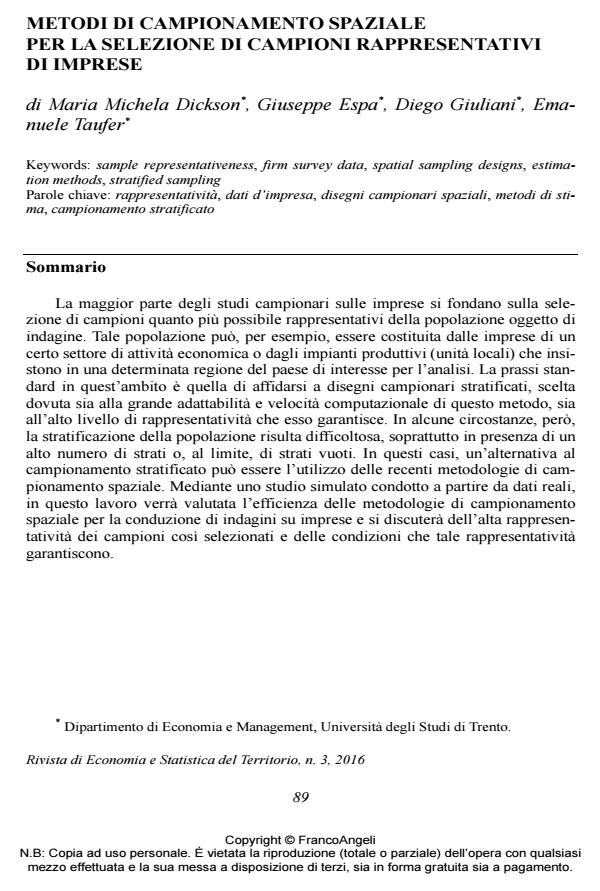Spatial sampling methods for selecting representative samples of firms
Journal title RIVISTA DI ECONOMIA E STATISTICA DEL TERRITORIO
Author/s Maria Michela Dickson, Giuseppe Espa, Diego Giuliani, Emanuele Taufer
Publishing Year 2017 Issue 2016/3
Language Italian Pages 11 P. 89-99 File size 248 KB
DOI 10.3280/REST2016-003006
DOI is like a bar code for intellectual property: to have more infomation
click here
Below, you can see the article first page
If you want to buy this article in PDF format, you can do it, following the instructions to buy download credits

FrancoAngeli is member of Publishers International Linking Association, Inc (PILA), a not-for-profit association which run the CrossRef service enabling links to and from online scholarly content.
Objectives An important issue in economic studies involving firms is the representativeness of selected sample of units, in order to mirror the distribution of population variables in the sample. Stratified sampling is one of the most used sampling scheme in this context, but sometimes it could be a computationally unfeasible design, due to population structure and/or variables characteristics. In the present work, the authors show that a valid alternative to stratification is represented by spatial sampling methods, which are not affected by the above-mentioned roblems.
Methods and Results
By means of a Monte Carlo simulation study on a real population of firms, the authors show that it is possible to use spatial sampling methodologies (Local Pivotal Methods and Spatially Correlated Poisson Sampling) as almost equally efficient alternatives to stratified sampling. The study has a dual nature. On one hand, it has been proved that spatial sampling lead to efficient estimates, evaluated in terms of relative RMSE, which can be equivalent to those obtained by stratification. On the other hand, by a comparison in terms of spatial balance index, the authors show that spatial methods bring to a very high level of representativeness.
Conclusions
Sample representativeness is a central issue in literature and practice. Stratified sampling guarantees that sampling data represent as better as possible the structure of population under study. In some cases, the implementation of this method became unfeasible. In the present work, it has been proved that it is possible an approach based on the use of spatial sampling methods, which are less subject to operational problems but they can lead to high level of representativeness.
Keywords: Sample representativeness, firm survey data, spatial sampling designs, estimation methods, stratified sampling
Jel codes: C13; C83; R30; R12
Maria Michela Dickson, Giuseppe Espa, Diego Giuliani, Emanuele Taufer, Metodi di campionamento spaziale per la selezione di campioni rappresentativi di imprese in "RIVISTA DI ECONOMIA E STATISTICA DEL TERRITORIO" 3/2016, pp 89-99, DOI: 10.3280/REST2016-003006